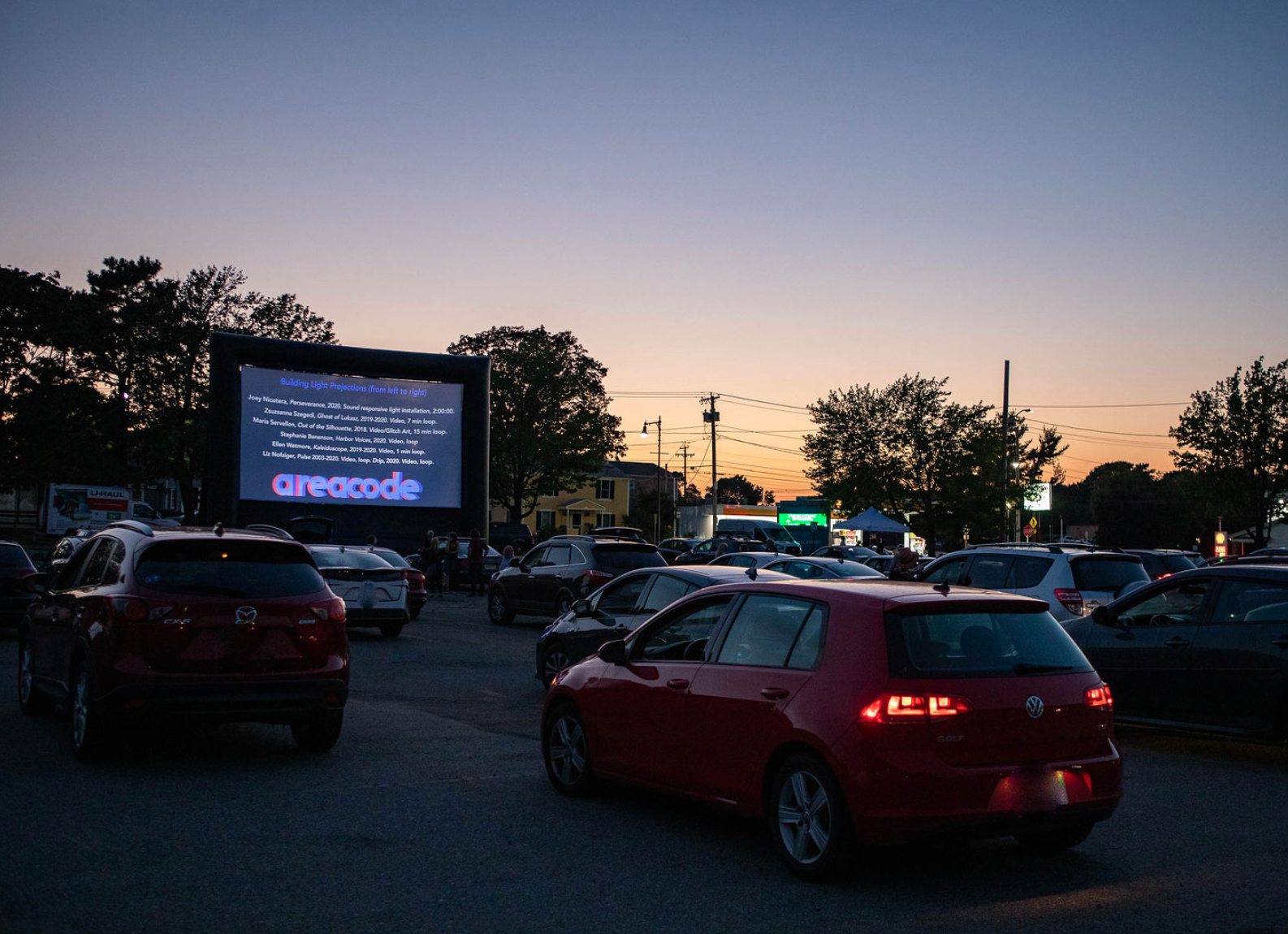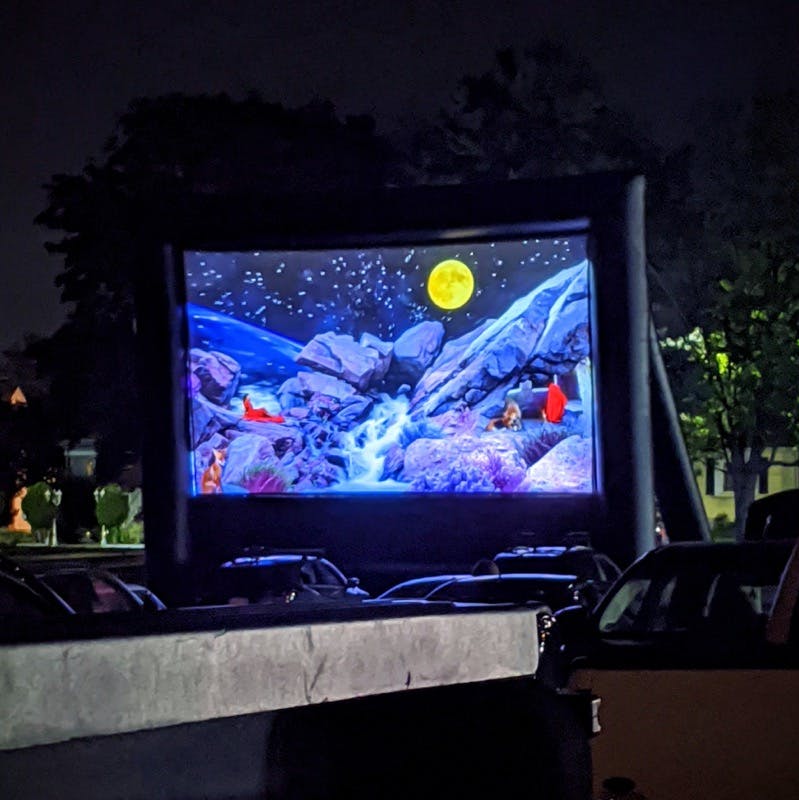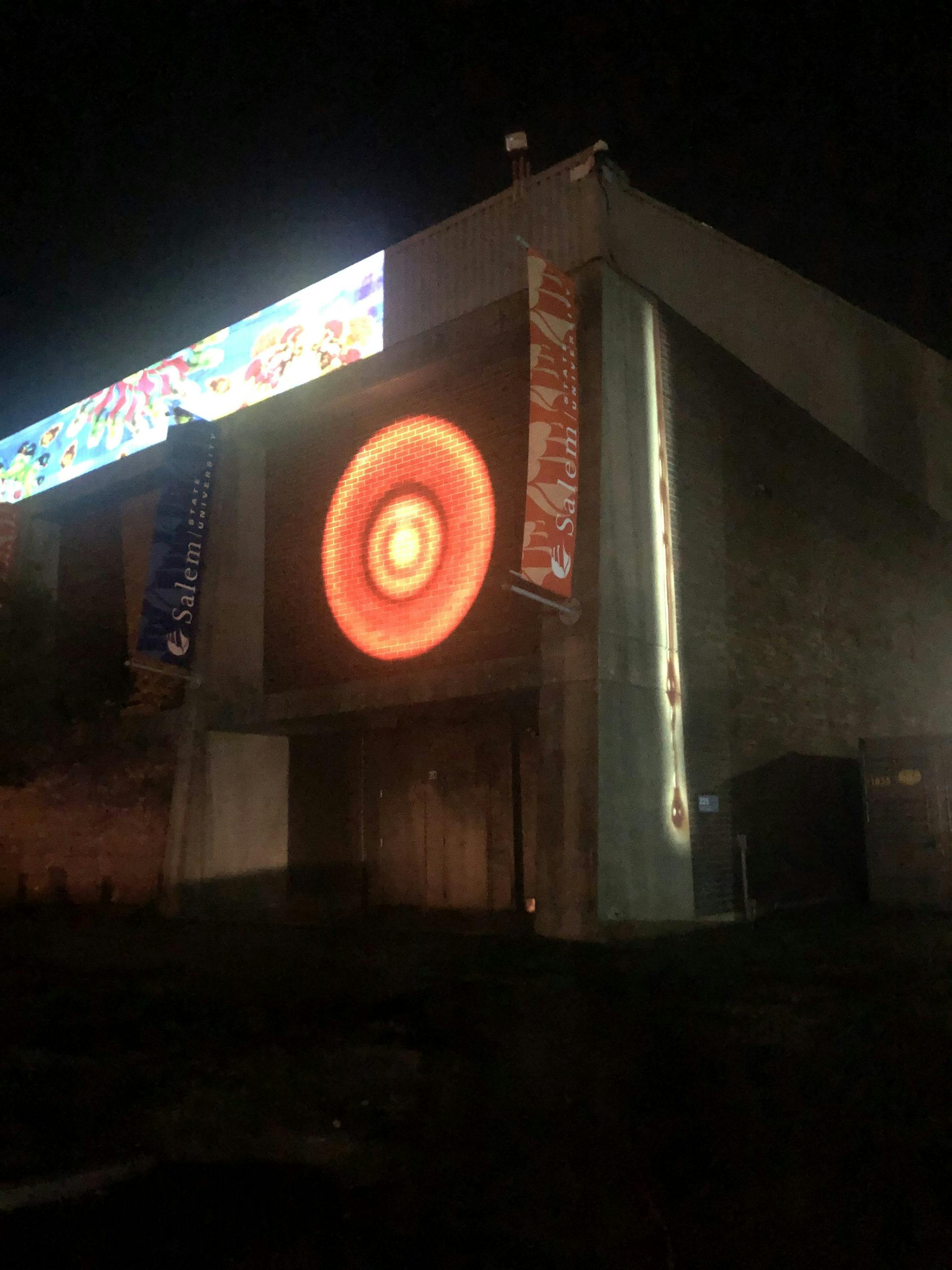While pulling into the parking lot of Salem State University, the site for AREA CODE Art Fair’s Video and Digital Art Drive-In Project last Friday night, the crackling energy in the air was palpable. Museum closures still abound and several galleries and community art spaces remain shuttered, so the drive-in event—which featured dozens of New England area artists—was for many the first free, local art event that could be enjoyed communally, with safe, socially distant protocols in several months. Fair organizers and curators David Guerra, Jen Mergel, Leonie Bradbury, and several others on the volunteer organizing team have been working for months to find a way for artists to show their work both on and offline in the midst of an ongoing pandemic. The resulting fair, which will run through the end of August, is complete with artist talks, storefront displays, an online platform for purchasing art, and performances. Bradbury, who served as juror for the drive-in portion of the fair, combed through more than 60 submissions as well as the video and digital works submitted to other sections. To determine the line-up, she searched for a wide range of work, “from really experimental computer-generated glitch type work to short documentary films…to fun animation pieces,” Bradbury explained. The throughline for all of it: a dynamic soundtrack. Bradbury felt that without compelling audio, it would be harder to connect to the content in this context. The audience tuned their radios to 96.5 FM to follow along from the comfort of their own cars. In addition to showcasing a stylistically diverse selection of artworks, Bradbury made a point to include a mix of well-known, experienced makers such as Maria Servellón and Allison Maria Rodriguez alongside emerging creatives such as Tyler Selfridge.
Online Only• Aug 20, 2020
Experimental Art Leaves the Museum and Heads for the Drive-In
Jacquinn Sinclair reviews the AREA CODE Art Fair Drive-In for video and digital art at Salem State University on August 14, 2020.
Review by Jacquinn Sinclair
A pop-up screen welcomed viewers just before sunset at Salem State University's O'Keefe Sports Complex. Image courtesy of John Andrews and Creative Collective.

A pop-up screen welcomed viewers just before sunset at Salem State University's O'Keefe Sports Complex. Image courtesy of John Andrews and Creative Collective.

Allison Maria Rodriguez’ Legends Breathe: Where Water Falls, (2019-2020) plays before a crowd of cars. Image courtesy of Amy Halliday.
Rodriguez, an interdisciplinary artist working predominantly in video installation, usually develops immersive experiential spaces. To help contextualize her digital piece, Legends Breathe: Where the Water Falls, Rodriguez added “sound support to go along with it, to make it a little more conducive to a single screen experience,” she explained. The animated work showed two women in red floating on a rock in space. The women stood on opposite sides of a waterfall with plants, foxes and a small sea urchin. Legends Breathe is an ongoing collection “about the power of creativity and the imagination and overcoming trauma,” Rodriguez shared. Known for magical realism, Rodriguez’ body of work focuses on interconnection. “It’s about how one piece of the universe is reliant on another and how we are all part of this larger circle,” she said. The Cuban-American creative has another piece, Subversive Dreams, on display in the windows of the Emerson College Media Art Gallery in Boston as part of the Special Projects section of the fair.
All of the works in the 115-minute show—made possible with the help of partners Salem State University, the City of Salem, Creative Collective, and LuminArtz—flooded the senses. Colorful explosions, abstract work, lush landscapes, bodies, faces, and other imagery, both calming and frightening, held the audience’s attention . The shifting groove and mood of Servellón’s between u & i & them, with its trippy, sometimes ominous vibe and the lessons tucked in Gina Siepel’s Motion Study: American Dream, Paul Turano’s A Message from the Magpie, and Selfridge’s animated Don’t Be a Prick were noteworthy.
Siepel’s work explores matters of place, history, and the construction of identity. In the video, she included a selection of first-hand stories that detailed what the American dream does or doesn’t mean while peering out of a train window. Meanwhile, Turano’s piece warned of the dangers of climate change. During the Southern Australia bush fires that burned over the past two years, the magpie bird began mimicking the sound of emergency sirens. In the video, the magpie parroted our role in the destruction of earth with poignant subtitles beneath its chirping. On the lighter side, Selfridge’s animated short film about self-acceptance centered on two cacti, Sagu and Sono, who spend their time arguing about their appearance. The younger cactus Sono tried to befriend Sagu who actively resisted. When Sono grew stronger and his flowers bloomed, he looked to Sagu for validation and acceptance. Though Sagu agreed that Sono was indeed beautiful, Sagu still wasn’t as kind as he could be. Sono, fed up with Sagu’s antics stomped off into the sunset, which elicited good-natured laughter from the crowd. The film was Selfridge’s senior thesis project.
Throughout the night, kaleidoscopic objects, a woman’s silhouette, and large white text along with other projections floated high above the crowd’s cars on a wall to the left of the main screen. Pulse—a circular red video projection by artist Liz Nofziger—throbbed on the wall while the audio pumped through the speakers. “We’ve all been forced [due to the pandemic] in more immediate and less immediate ways to think about our own mortality…and this piece with its kind of irregular pulse,” Nofziger said, “feels related to body…and vulnerability.” Nofziger typically creates site-specific work, but she thought Pulse, previously available for viewing in a gallery on a monitor, was an appropriate piece to revive for the fair.

Liz Nofziger’s Pulse (2003-2020) projected above event. Image courtesy of John Andrews and Creative Collective.
The most challenging aspect of the evening was not being able to press rewind and revisit the work again. After each act and between each piece, a chorus of honking horns conveyed approval in lieu of clapping. Every so often, show goers were urged to donate to help support the artists via Venmo or PayPal from the safety of their cars. But overall, what seemed to matter most—aside from the compelling pieces that activated the site on and off-screen—was that we were all engaging with art in person, in a crowd, for the first time in months. The horns, muted conversations, and even a little dancing nearby nodded to a sense of normalcy that continues to elude most of our daily lives, but most of us have been aching for. For those who missed the sold-out AREA CODE Art Fair’s Video and Digital Art Drive-In Project, Bradbury is currently exploring another location and partnership. If it works out, we’ll all be together—but safely apart—to view art again soon.
AREA CODE Art Fair will run across several platforms and locations through August 31, 2020. Learn more at areacodeartfair.com.
